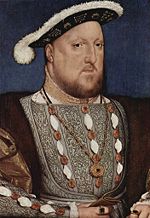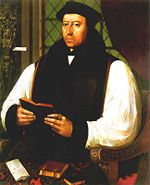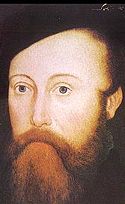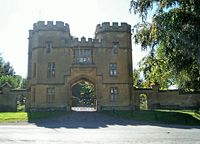Catherine Parr
| Katherine Parr | ||
|---|---|---|
| Queen Consort of England | ||

| ||
| Catherine Parr | ||
| Born | ca. 1512 | |
| Kendal Castle | ||
| Died | 5 September 1548 | |
| Sudeley Castle, Gloucestershire | ||
| Consort | 1543 - 1547 | |
| Consort to | Henry VIII | |
| Issue | Mary Seymour | |
| Father | Sir Thomas Parr | |
| Mother | Maud Green | |
Catherine Parr (c. 1512 – September 5, 1548), also known as Katherine or Katharine Parr(e), was the last of the six wives of Henry VIII of England. She was queen consort of England during 1543–1547, then dowager queen of England. She was the most married English queen, with four husbands.
Early life and marriages
Catherine was the daughter of Sir Thomas Parr of Kendal and Maud Greene. She was the eldest of three children, probably born in 1512, followed by a brother, William and a sister, Anne. Thomas and Maud were courtiers during the early years of Henry VIII's reign. Thomas was knighted at the king's coronation in 1509, and Maud was a lady-in-waiting to his first queen, Catharine of Aragon after whom Catherine was named. Thomas died in 1517 and she was sent to live with her uncle, Sir William Parr in Northamptonshire where she received a good education.
At the age of 15, Catherine became the second wife of Edward Borough, 2nd Baron Borough of Gainsborough, in 1529. Not of good health, he died in early 1533. They had no children. In the summer of 1534, aged 22, she married John Nevill, 3rd Baron Latymer of Snape, North Yorkshire. He had two children, for whom Catherine reportedly cared well. Neville and Catherine, as well as the two children, were held hostage in 1536 by northern rebels who fought against King Henry's religious policies during the Pilgrimage of Grace. Afterward, her husband reported to the king about his imprisonment. He soon died, in March 1543. Catherine had no children with Neville.
As Catherine nursed the ailing Neville near the end of his life, she spent more time at court, where she became acquainted with vital young men her own age. At 31, she was a wealthy young widow and began a relationship with Thomas Seymour, the brother of the late queen Jane Seymour and uncle to the future king, Edward VI. During this time, Catherine also spent time in the household of Henry VIII's daughter by Catherine of Aragon, Mary. It was here that Catherine caught the attention of the king. Henry took a liking to her, and she was obliged to accept his proposal of marriage instead of that of Thomas Seymour.
A dutiful woman, Catherine entered into her third marriage with an older, sickly husband. It was not easy for her, and she wrote to Seymour: "As truly as God is God, my mind was fully bent... to marry you before any man I know. But the will of God was different."[1]
Education
Catherine and her siblings were educated at their mother's direction after the death of their father in the hope of securing good marriages. Catherine was fluent in French, Italian, and Latin, and began learning Greek, and some sources say Spanish, when she was queen. [2]She was also a patron of the arts and music. In 1545, she was the first English queen to publish a book under her own name: “Prayers or Meditations.” Her other book, “The Lamentation of a Sinner”, was published after the death of Henry VIII during the last year of her life.
Queen consort of England and Ireland
| The Six Wives of King Henry VIII |
|---|
Catherine married Henry VIII on July 12, 1543 at Hampton Court Palace, being his sixth wife. She was the first English queen consort to enjoy the new title Queen of Ireland following Henry's adoption of the title of Ireland's monarch. As queen, Catherine was partially responsible for reconciling Henry with his daughters from his first two marriages, who would later become Queens regnant, Mary and Elizabeth. She also developed a good relationship with Henry's son Edward, who preceded his sisters to the throne as Edward VI. When she became queen, her uncle Baron Parr of Horton became her lord chamberlain.

Their marriage was consummated, although Henry was reportedly occasionally impotent. Catharine was known to order black satin nightdresses and would sit holding the king's infected leg in her lap, or sit in his lap herself. They both loved music and she would dance for him. Their marriage seemed a happy one, even though lacking in passion.
For three months, from July to September 1544, Catherine was appointed queen regent by Henry as he went on his last, unsuccessful, campaign in France. Thanks to her uncle having been appointed as a member of her regency council and to the sympathies of her councilors Thomas Cranmer and Edward Seymour, earl of Hertford, Catherine obtained effective control faced no serious challenge to her authority. She handled provision, finances, and musters for Henry's French campaign. She also signed five royal proclamations and maintained constant contact with her northern lieutenant, the Earl of Shrewsbury, over the complex and unstable situation with Scotland.
It is thought that her actions as regent, together with her strength of character and later religious convictions, greatly influenced her stepdaughter Elizabeth.
Religious views and controversy
Catherine's religious views were complex, and the issue is clouded by the sparseness of evidence. Although she must have been brought up as a Catholic—given her birth before the English Reformation and her being named for the Catholic Catherine of Aragon—she later became sympathetic and interested in the "New Faith." She and her younger friends had grown up after Martin Luther's triumph in Germany. Evangelical Protestantism was attractive to her with its emphasis on freedom of Christian conscience and the individual's reading of the Bible. She drew young thinkers to her, like Mile Coverdale, John Parkhurst, Anthony Cope and others. She also became close friends with Thomas Cranmer, the archbishop of Canterbury, and Catherine Willoughby, the duchess of Suffolk, another young, educated woman with an elderly husband.
Catherine clearly held strong reformed ideas after Henry's death, when her Lamentacions of a synner (Lamentations of a Sinner) were published in late 1547. However, her commissioning of the translation of Desiderius Erasmus' Paraphrases implies that she may have been influenced by Erasmian humanism and pietism.
Catherine was reformist enough to be viewed with suspicion by Catholic and anti-Evangelical officials such as Bishop Stephen Gardiner and Chancellor Thomas Wriothesley, 1st Earl of Southampton who tried to turn the king against her in 1546. Angered, she wrote, "Is it not extreme wickedness to charge the holy sanctified word of God with the offenses of man? To allege the Scriptures to be perilous learning because certain readers thereof fall into heresies?"
The king's council soon became alarmed by the permissive religious climate and passed the Act for the Advancement of the True Religion. It disallowed the "lower sort" from studying the Bible in English but was later amended to allow noblewomen the right to read the scriptures but but stipulated that they should not engage in religious debate. Catherine, feeling secure in her position at court, ignored the law and continued to engage in religious discussions. Her friend Anne Askew was arrested and horribly tortured, but refused to implicate the queen. When Anne was executed, Catherine threw away her most dangerously evangelical books. Since the king still showed much affection toward her, she felt she was safe. But her Catholic enemies conspired to have her removed and punished, as they did with Thomas Cromwell for his part in arranging Henry's marriage alliance with the strongly Lutheran family of Anne of Cleves.
A warrant was drawn up for Catherine's arrest. However, when the king confronted her about her religious arguments with him, she managed to reconcile with with him, after vowing that she had only argued about religion with him to take his mind off the suffering caused by his ulcerous leg. This won his heart, and he reportedly declared: "Then Kate, we are friends again."[3]
However, the king's council had not yet been informed of the reconciliation. When Wriothesley and 40 guards came with the warrant to arrest Catharine the next day, the king himself defended her, beating and cursing them. Henry also gave her gifts of jewels in expression of his satisfaction with her.
Final marriage, childbirth and death
Henry VIII died in January 1547, leaving Catherine one of the wealthiest women in England. Thomas Seymour had been made Master-General of the Ordnance in 1544 and Lord Warden of the Cinque Ports in 1545. He returned to court a few months before Henry's death and saw his brother Edward become Lord Protector of England and, in effect, ruler of the realm as Regent for his nephew, Henry VIII's minor son and successor, the short-lived Edward VI. As part of a 'unfulfilled gifts clause' left unmentioned in Henry's will, Thomas was granted the title Baron Seymour of Sudeley. However, Thomas' fervent desire was to unseat and replace his brother as Lord Protector.
When Henry VIII died there was probable expectation for Catherine to play the role of dowager queen for the new nine-year-old king, Edward VI, instead, just a few months after Henry’s death, Catherine secretly married her former love, Thomas Seymour, 1st Baron Seymour of Sudeley Lord High Admiral. The secrecy of her marriage and the short mourning period caused a scandal. Yet Catherine was still able to take guardianship of Princess Elizabeth and her husband Thomas purchased the wardship of the king’s cousin, Lady Jane Grey.
Having had no children from her first three marriages, Catherine became pregnant for the first time, by Seymour, at age thirty-five. But her happiness was short-lived.
She had a rivalry over precedence with Anne Stanhope , the wife of her husband's brother, Edward Seymour, 1st Duke of Somerset and other arguments over Catherine's possessions, especially the jewelry Henry VIII had given her. Thomas Seymour was alleged to have taken liberties with the teen aged Princess Elizabeth (Catherine's step-daughter and future Elizabeth I), who was living in their household, and had reputedly plotted to marry her. To protect Elisabeth, Catherine had to send her to live in another household which caused a permanent rift between the women.
Catherine gave birth to her only child - a daughter, Mary Seymour - on August 30, 1548, but Catherine died only six days later, on September 5, 1548, at Sudeley Castle in Gloucestershire, from puerperal fever like Jane Seymour before her.
Thomas Seymour, an ambitious and jealous man, was eager to either replace his brother or kidnap the king, but was caught breaking into the young king's palace. He was sent to the Tower of London, charged with thirty-three counts of treason and later beheaded, less than a year later. Their daughter, Mary, was taken to live with Catherine (Brandon) Willoughby, dowager Duchess of Suffolk, a close friend of Catherine's. After a year and a half, Mary's property was restored to her by an Act of Parliament, easing the burden of the infant's household on the Duchess. The last mention of Mary Seymour on record is on her second birthday, and although stories circulated that she eventually married and had children, most historians believe she died as a child.
Legacy
Catherine Parr was the final and sixth wife of King Henry VIII. Twice widowed by sickly men, after much consideration and during a time in Henry VIII's court when the wife of the king could die at any moment by the king's whim or by the betrayal of other — usually jealous, courtiers — Catherine followed her conscience and wed yet another, older, sickly man. Although she loved Thomas Seymour, she sacrificed her own desires and entered into a marriage with the king with dignity, patience, kindness and moral fortitude. This example of loyalty to the crown kept her in good reputation throughout English history.
Favoring education, and culture she also helped reconcile her three step-children to Henry VIII. Her desire to aid the children allowed Elizabeth and Edward a very good and liberal education which would benefit the future of England when Elizabeth I took the throne. Her support of the 'new religion' encouraged the translation of religious works into English so that others could read them for themselves and furthered the protestant reformation.
She stands out as the first English queen to publish books in her own name, encouraging others toward religious dialog and contemplation. She stands as a pioneer for women.
Remains
In 1782, a gentleman by the name of John Locust discovered the coffin of Queen Catherine at the ruins of the Sudeley Castle chapel. He opened the coffin and observed that the body, after 234 years, was in a surprisingly good condition. Reportedly the flesh on one of her arms was still white and moist. After taking a few locks of her hair, he closed the coffin and returned it to the grave.
The coffin was opened a few more times in the next ten years and in 1792 some drunken men buried it upside down and in a rough way. When the coffin was officially reopened in 1817, nothing but a skeleton remained. Her remains were then moved to the tomb of Lord Chandos whose family owned the castle at that time. In later years the chapel was rebuilt by Sir John Scott and a proper altar-tomb was erected for Queen Catherine.
Some of Catherine Parr's writings are available from the Women Writers Project at Brown University [4].
Historiography
The popular myth that Catherine acted more as her husband's nurse than his wife was born in the 19th century from the work of Victorian moralist and proto-feminist, Agnes Strickland. This assumption has been challenged by David Starkey in his book Six Wives in which he points out that such a situation would have been vaguely obscene to the Tudors, given that Henry had a huge staff of physicians waiting on him hand and foot, and Catherine was a woman expected to live up to the heavy expectations of queenly dignity.
Catherine's good sense, moral rectitude, passionate religious commitment and strong sense of loyalty and devotion have earned her many admirers among historians. These include David Starkey, feminist activist Karen Lindsey, Lady Antonia Fraser, Alison Weir, Carolly Erickson, and Alison Plowden.
Titles
- Miss Catherine Parr (1512-1529)
- Lady Borough (1529-1534)
- Lady Latymer (1534-1543)
- HM Queen Catherine (1543-1547)
- Lady Seymour (1547-1548)
See also
- Henry VIII of England
- Thomas Seymour
Notes
All retrieved May 20, 2008.
- ↑ Catherine Parr's life englishhistory.net
- ↑ The life of Catherine Parr tudorhistory.org
- ↑ Ibid.
- ↑ Women Writers Project www.wwp.brown.edu
ReferencesISBN links support NWE through referral fees
- Fraser, Antonia. The Wives of Henry VIII, Vintage, 1993. ISBN 978-0679730019
- James, Susan E. Kateryn Parr: The Making of a Queen (Women and Gender in Early Modern England, 1500-1750), Ashgate Publishers, 1999. ISBN 978-1840146837
- Lindsey, Karen. Divorced, Beheaded, Survived: A Feminist Reinterpretation Of The Wives Of Henry VIII, Da Capo Press, 1996. ISBN 978-0201408232
- Plowden, Allison. Tudor Women, Sutton Publishing, 1998. ISBN 978-0750928809
- ________________. The House of Tudor, Sutton Publishing, 2003. ISBN 978-0750932400
- Starkey, David. Six Wives : The Queens of Henry VIII, Harper Perennial, 2004. ISBN 978-0060005504
- Strong, Roy. Artists of the Tudor Court: The Portrait Miniature Rediscovered 1520-1620, Victoria & Albert Museum exhibit catalog, 1983. ISBN 0905209346
- Weir, Alison. The Six Wives of Henry VIII, Grove Press, 1991. ISBN 0-8021-3683-4
External links
Retrieved May 20, 2008.
- A detailed story of Catherine Parr's life englishhistory.net
- Sudeley Castle - One time home, and burial place of Catherine Parr. www.sudeleycastle.co.uk
- A quick look at Catherine's life with some great pictures in the gallery. tudorhistory.org
- Performing Arts Department to debut Highness by Carolyn Kras, publisher: The Record, describing the relationship between Elizabeth and Catherine Parr news-info.wustl.edu
| English royalty | ||
|---|---|---|
| Preceded by: Catherine Howard |
Queen Consort of England 12 July, 1543 - 28 January, 1547 |
Succeeded by: Lord Guildford Dudley |
George, Duke of Cumberland (1702-1707) · Mary of Modena (1685-1688) · Catherine of Braganza (1662-1685) · Henrietta Maria of France (1625-1649) · Anne of Denmark (1603-1619) · Philip II of Spain (1554-1558) · Lord Guildford Dudley (1553) · Catherine Parr (1543-1547) · Catherine Howard (1540-1542) · Anne of Cleves (1540) · Jane Seymour (1536-1537) · Anne Boleyn (1533-1536) · Catherine of Aragon (1509-1533) · Elizabeth of York (1486-1503) · Anne Neville (1483-1485) · Elizabeth Woodville (1464-1483) · Margaret of Anjou (1445-1471) · Catherine of Valois (1420-1422) · Joanna of Navarre (1403-1413) · Isabella of Valois (1396-1399) · Anne of Bohemia (1383-1394) · Philippa of Hainault (1328-1369) · Isabella of France (1308-1327) · Marguerite of France (1299-1307) · Eleanor of Castile (1272-1290) · Eleanor of Provence (1236-1272) · Isabella of Angoulême (1200-1216) · Berengaria of Navarre (1191-1199) · Eleanor of Aquitaine (1154-1189) · Matilda of Boulogne (1135-1152) · Geoffrey V, Count of Anjou (1141) · Adeliza of Louvain (1121-1135) · Matilda of Scotland (1100-1118) · Matilda of Flanders (1066-1083)
| Persondata | |
|---|---|
| NAME | Parr, Catherine |
| ALTERNATIVE NAMES | |
| SHORT DESCRIPTION | Queen Consort of Henry VIII |
| DATE OF BIRTH | ca. 1512 |
| PLACE OF BIRTH | London, England |
| DATE OF DEATH | September 7, 1548 |
| PLACE OF DEATH | Gloucestershire, England |
Credits
New World Encyclopedia writers and editors rewrote and completed the Wikipedia article in accordance with New World Encyclopedia standards. This article abides by terms of the Creative Commons CC-by-sa 3.0 License (CC-by-sa), which may be used and disseminated with proper attribution. Credit is due under the terms of this license that can reference both the New World Encyclopedia contributors and the selfless volunteer contributors of the Wikimedia Foundation. To cite this article click here for a list of acceptable citing formats.The history of earlier contributions by wikipedians is accessible to researchers here:
The history of this article since it was imported to New World Encyclopedia:
Note: Some restrictions may apply to use of individual images which are separately licensed.



